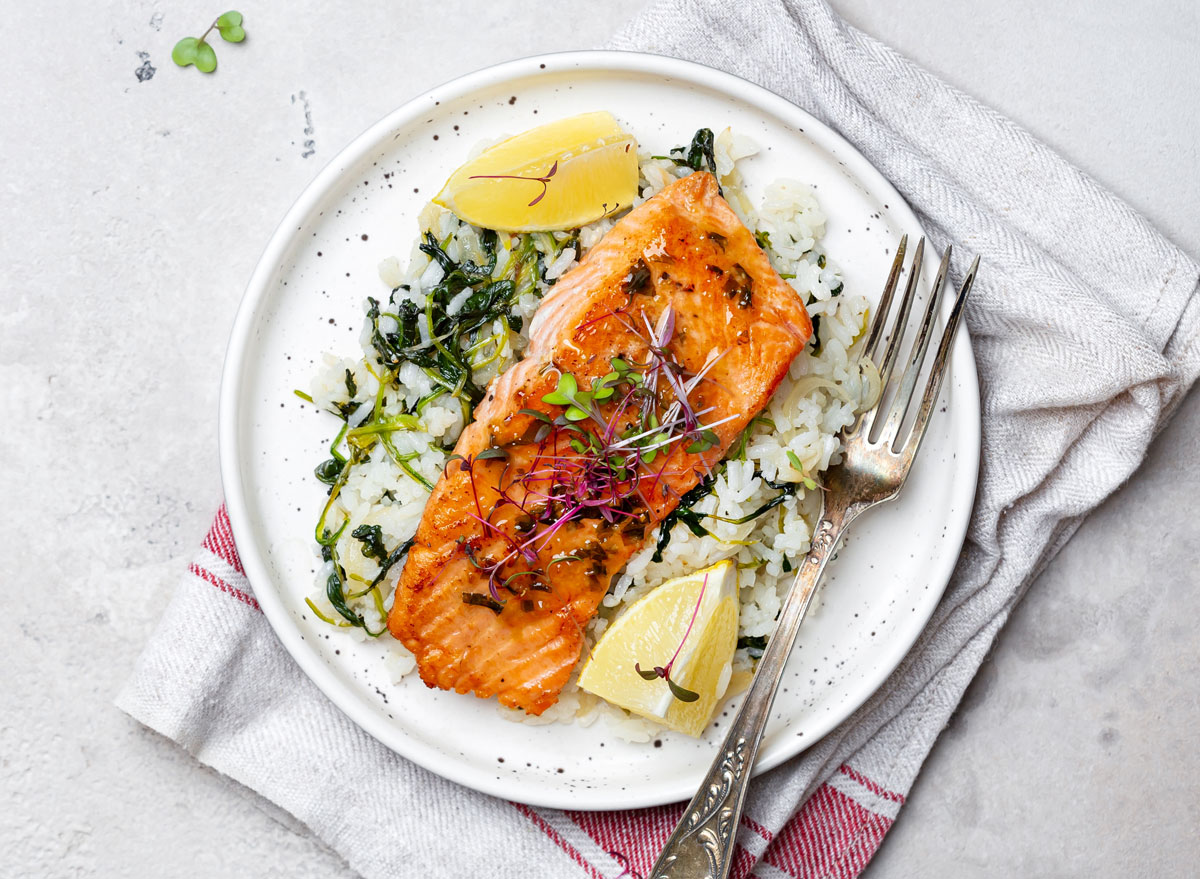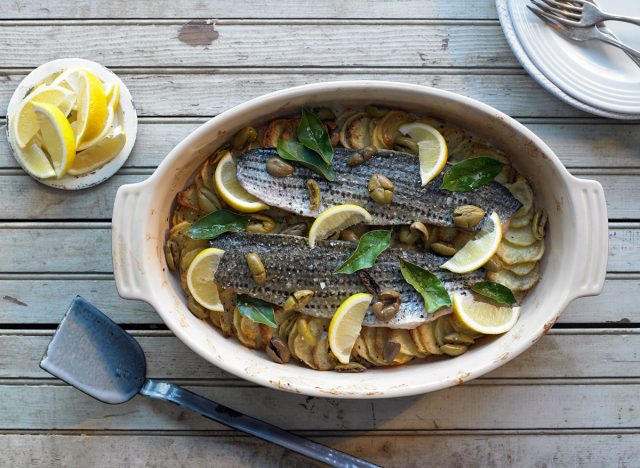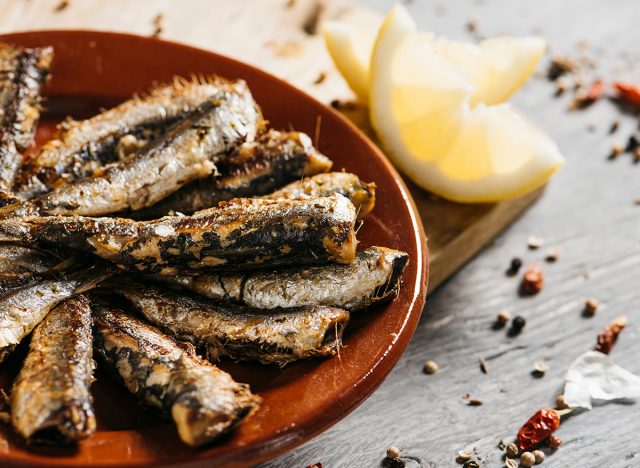The 12 Healthiest Fish You Should Be Eating—and 3 to Avoid

Fish is one of the most nutrient-dense foods out there. Some may even venture to call certain varieties of fish a superfood, thanks to the slew of nutrients a serving provides. In fact, eating fish is linked to a slew of health benefits, including heart health support and brain health. The Dietary Guidelines for Americans recommends adults eat at least 8 ounces of fish per week (based on a 2,000-calorie diet). Pregnant people are told to limit their fish consumption to 8-12 ounces every week and to stick to low mercury choices.
You may be sold on the idea of eating enough fish, but with an estimated 20,000 species of fish in the world, it can understandably be difficult for people to know which fish is the healthiest to eat.
To help you on your quest to pick the healthiest fish, we picked the most convenient, affordable, and nutrient-dense choices and listed them below. But before you start digging into your seafood pick, keep in mind that how you prepare your fish can impact how healthy it is too. Specifically, deep frying your fish or drowning your fish in melted butter won’t make for a super healthy meal, regardless of which fish you choose. Topping your fish with a creamy sauce isn’t recommended either, as many of these can be loaded with saturated fat (sorry, tartar sauce, lovers). Your best bet will be to grill, bake, or sauté your fish and enjoy it with a serving of veggies and a healthy carb (like quinoa or a baked potato).
The 12 healthiest fish to eat
As for which fish you should add to your healthy diet and which are best left on the grocery store shelf, here are some of our top picks of the healthiest fish choices along with three that we don’t stand behind when it comes to an option that should be enjoyed frequently. Read on, and for more, don’t miss 20 Quick and Healthy Fish Recipes You Can Make in 15 Minutes (or Less!)
1. Norwegian Salmon
Norwegian salmon is a top pick because of its taste, texture, and nutrition. These salmon thrive in Norway’s ice-cold, pristine waters and are farmed-raised following strict standards of sustainability and thoughtful care for ocean health. Norwegian salmon is also antibiotic-free, non-GMO, and it is a good source of heart-healthy omega-3 fatty acids. Salmon from Norway is also packed full of vitamins A, D, B12, and riboflavin.
2. Canned Skipjack Tuna
Canned tuna is both economical and accessible – two factors that make eating fish much more approachable for many people. Among the canned tuna options out there, skipjack tends to be lower in mercury than other options, like albacore. Opt for choices that don’t have added salt, and make sure the can you are choosing isn’t lined with BPA. Cans will typically indicate if it is free from this lining.
3. Cod

As long as it isn’t fried, cod is a protein-packed fish that is mild in flavor and easy to cook. Bonus? Cod is one of the best sources of iodine which can help support thyroid health.
If sustainability is a priority, Cod from Norway is sustainably wild-caught in cold, clear Norwegian waters. Each serving has about 100 calories per 3-ounce portion and it is also rich in omega-3 fatty acids, vitamins A, D, and B12, and proteins. And of course, iodine.
4. Pacific Halibut
Halibut is a fish choice with a low to moderate mercury content that contains a slew of nutrients, including high-quality protein, DHA omega-3 fatty acids, and vitamin B12. It is also a source of selenium, a nutrient that may support our immune health.
Pacific halibut tend to have low rates of bycatch and causes little habitat damage.
5. Striped Bass

AKA rockfish or the Atlantic striped bass, striped bass is a healthy choice and it is delicious to eat. This white flaky fish is packed with vitamin D, vitamin E, and many other nutrients. It is also lower on the mercury-containing scale, and lower in fat than many other fish options.
6. Arctic Char
This coldwater fish is part of both the trout and salmon families. Mild in flavor and rich in healthy fats, this fish is easy to cook and packed with nutrients.
7. Grouper
Grouper may have more mercury than some other fish options, like salmon and cod. But don’t let that stop you from enjoying this saltwater fish once in a while. This fish is a source of many important nutrients, it is low in saturated fat, and it makes for a delicious ingredient in a classic fish sandwich.
8. Flounder

For people who don’t like eating a “fishy” fish, flounder can be a nice solution thanks to its mild flavor. This fish is a source of lean protein, healthy fats, and many micronutrients. Enjoy it baked with olive oil, lemon juice, capers, and parsley for a simple dish with a nutrient-packed fish.
9. Wild Alaska Pollock
Unlike other whitefish, Wild Alaska Pollock are raised and caught in their natural habitat. It is a low-fat, protein-rich, heart-healthy whitefish with nutrients such as vitamin B-12 and omega-3 fatty acids, making it one of the most nutritious natural foods in the world.
Wild Alaska Pollock is known as the ultimate kid-friendly fish, with a mild taste and texture that leaves kids wanting more. Harvested in the clean, remote waters of Alaska, Wild Alaska Pollock is mercury-safe, too.
10. Herring
Herring is an oily fish, making it a great choice if you are trying to get a boost of omega-3 fatty acids, with more omegas than our beloved salmon when comparing serving-for-serving.
Herring is one of the lowest mercury-containing fish out there, and it is a sustainable fish as well.
11. Atlantic Mackerel
The nutrients found in mackerel will have you saying “holy mackerel” after you read the list. From protein to selenium to important DHA omega-3 fatty acids, mackerel has a pretty impressive nutritional content. It is also a lower-mercury fish and it is easy to include in many dishes.
Note that king mackerel is high in methylmercury, so that option should be limited.
12. Sardines

If you are a sardine lover, then you will be thrilled to know that these tiny fish are a low-mercury source of healthy fats, protein, and important micronutrients like vitamin B12 and choline. Sardines can be added to pasta dishes, salads, and even enjoyed on top of toast for a quick and healthy breakfast.
Three Fish To Avoid
1. Swordfish
Swordfish is a large fish that can be extremely high in methylmercury, a heavy metal that, when consumed in large quantities, can be linked to negative brain health outcomes. If you have a choice of which fish to serve, skip the swordfish and go for an option that is lower in this heavy metal. Marlin, shark, and tilefish are other fish examples that contain high levels of mercury.
2. Bluefin Tuna
Bluefin tuna may be delicious to eat, but they are heavily overfished and their population is severely declined. Choosing this fish contributes to the demand, which can lead to illegal fishing practices and continued overfishing.
3. Eel
While it may be delicious as an ingredient in your favorite sushi roll, eel may not be the best choice to consume frequently. It may be higher in mercury and certain varieties are endangered. Reducing the eel population can negatively affect the mussel population, as eels carry mussel larvae, allowing them to build new populations. Without enough eel, the mussel population may become affected too.
- Source: https://www.sciencedirect.com/science/article/pii/S0308814621024511
- Source: https://fdc.nal.usda.gov/fdc-app.html#/food-details/171955/nutrients
- Source: https://www.fda.gov/food/consumers/advice-about-eating-fish
- Source: https://fdc.nal.usda.gov/fdc-app.html#/food-details/2341675/nutrients
- Source: https://www.fisheries.noaa.gov/alaska/bycatch/halibut-bycatch-rates-alaska
- Source: https://fdc.nal.usda.gov/fdc-app.html#/food-details/171948/nutrients
- Source: https://www.fda.gov/media/102331/download
- Source: https://fdc.nal.usda.gov/fdc-app.html#/food-details/171962/nutrients
- Source: https://fdc.nal.usda.gov/fdc-app.html#/food-details/174196/nutrients
- Source: https://fdc.nal.usda.gov/fdc-app.html#/food-details/173725/nutrients
- Source: https://fdc.nal.usda.gov/fdc-app.html#/food-details/175116/nutrients
- Source: https://www.fda.gov/food/environmental-contaminants-food/mercury-levels-commercial-fish-and-shellfish-1990-2012
- Source: https://fdc.nal.usda.gov/fdc-app.html#/food-details/175119/nutrients
- Source: https://www.fda.gov/food/environmental-contaminants-food/fdaepa-2004-advice-what-you-need-know-about-mercury-fish-and-shellfish
- Source: https://fdc.nal.usda.gov/fdc-app.html#/food-details/2341708/nutrients
- Source: https://www.fda.gov/media/102331/download
- Source: https://pubmed.ncbi.nlm.nih.gov/29777524/
- Source: https://pubmed.ncbi.nlm.nih.gov/36778145/









